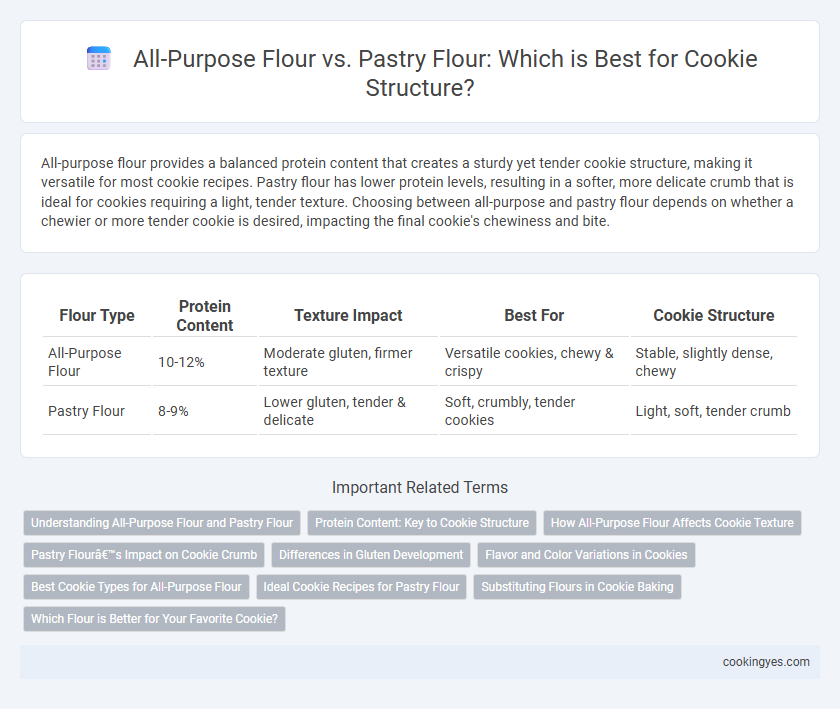All-purpose flour provides a balanced protein content that creates a sturdy yet tender cookie structure, making it versatile for most cookie recipes. Pastry flour has lower protein levels, resulting in a softer, more delicate crumb that is ideal for cookies requiring a light, tender texture. Choosing between all-purpose and pastry flour depends on whether a chewier or more tender cookie is desired, impacting the final cookie's chewiness and bite.
Table of Comparison
| Flour Type | Protein Content | Texture Impact | Best For | Cookie Structure |
|---|---|---|---|---|
| All-Purpose Flour | 10-12% | Moderate gluten, firmer texture | Versatile cookies, chewy & crispy | Stable, slightly dense, chewy |
| Pastry Flour | 8-9% | Lower gluten, tender & delicate | Soft, crumbly, tender cookies | Light, soft, tender crumb |
Understanding All-Purpose Flour and Pastry Flour
All-purpose flour contains a moderate protein content of 10-12%, providing balanced gluten development that yields cookies with a sturdy yet tender structure. Pastry flour has a lower protein content of 7-9%, resulting in softer, more delicate cookies with a tender crumb due to reduced gluten formation. Choosing between all-purpose and pastry flour directly influences cookie texture, affecting chewiness and crumb softness.
Protein Content: Key to Cookie Structure
Protein content in all-purpose flour ranges from 10-12%, providing moderate gluten formation that results in a balanced cookie structure with a chewy yet tender texture. Pastry flour, with a lower protein content of 7-9%, produces weaker gluten development, leading to softer, more delicate cookies with a finer crumb. Selecting the right flour based on protein content is essential for achieving the desired cookie texture and structural integrity.
How All-Purpose Flour Affects Cookie Texture
All-purpose flour, with its moderate protein content of 10-12%, provides cookies with a balanced structure, combining tenderness and chewiness. The gluten development in all-purpose flour creates a sturdier texture that holds shape well, resulting in cookies that are slightly crisp on the edges and soft inside. Using all-purpose flour yields cookies with a reliable crumb and a satisfying bite, suitable for a wide range of cookie recipes.
Pastry Flour’s Impact on Cookie Crumb
Pastry flour, with its lower protein content compared to all-purpose flour, produces a tender and delicate cookie crumb by minimizing gluten development. This flour enhances cookie softness and flakiness, resulting in a finer, more crumbly texture ideal for melt-in-your-mouth treats. Using pastry flour balances structure and tenderness, delivering cookies with a moist and supple interior.
Differences in Gluten Development
All-purpose flour contains higher protein content (10-12%) compared to pastry flour (7-9%), resulting in more gluten development that creates a chewier cookie texture. Pastry flour's lower gluten potential produces a tender, crumbly structure, ideal for delicate cookies requiring softness and lightness. Choosing between these flours affects cookie density and mouthfeel due to their distinct gluten-forming capacities.
Flavor and Color Variations in Cookies
All-purpose flour creates cookies with a balanced texture and a slightly neutral flavor, while pastry flour, with its lower protein content, yields tender, delicate cookies that often develop a lighter color due to less gluten formation. The choice of flour influences Maillard reaction intensity, affecting both flavor depth and the golden-brown hue of cookies. Using pastry flour enhances subtle sweetness and a softer crumb, whereas all-purpose flour produces a chewier texture with more pronounced browning.
Best Cookie Types for All-Purpose Flour
All-purpose flour, with its moderate protein content of 10-12%, provides a balanced structure ideal for chewy and crispy cookies like chocolate chip and oatmeal. Its versatility makes it suitable for cookies requiring a sturdy yet tender crumb, supporting even spreading and golden browning. Pastry flour, having a lower protein content of 7-9%, produces softer, more delicate cookies but lacks the strength needed for denser, chewy varieties that all-purpose flour excels in.
Ideal Cookie Recipes for Pastry Flour
Pastry flour, with a protein content of 8-9%, creates tender, delicate cookie structures by producing less gluten than all-purpose flour's 10-12%. Ideal cookie recipes using pastry flour emphasize softness and crumbly texture, perfect for shortbread, sugar cookies, and snickerdoodles. This flour enhances moisture retention and reduces toughness, making it essential for cookies that require a finer, melt-in-the-mouth bite.
Substituting Flours in Cookie Baking
When substituting all-purpose flour for pastry flour in cookie baking, it's important to consider protein content differences, as all-purpose flour typically contains 10-12% protein while pastry flour has around 8-9%. Higher protein in all-purpose flour creates a firmer cookie structure with more gluten development, resulting in chewier textures compared to the tender, crumbly texture produced by pastry flour. Adjusting baking time and adding a small amount of cornstarch can help mimic pastry flour's delicate structure when using all-purpose flour as a substitute.
Which Flour is Better for Your Favorite Cookie?
All-purpose flour contains a higher protein content (around 10-12%) compared to pastry flour (approximately 8-9%), making it better for cookies that require a sturdier, chewier texture. Pastry flour produces a softer, more tender cookie due to its lower protein level, which limits gluten development ideal for delicate crumb structures. Depending on whether you prefer crisp edges or melt-in-your-mouth softness, all-purpose flour is better for robust cookies while pastry flour excels in light, tender cookies.
All-purpose flour vs Pastry flour for cookie structure Infographic

 cookingyes.com
cookingyes.com